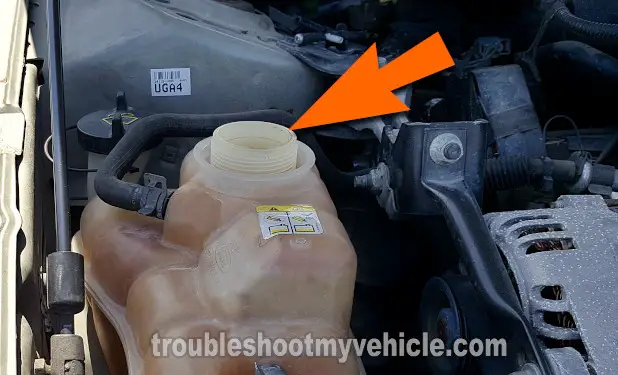TEST 2: Exhaust Gases Shooting Out Of An Open Radiator

The second most common test, to see if the head gasket on your 3.0L, 3.8L Ford car (or mini-van, pick up) is blown or not, is to check if engine compression and/or combustion gases are escaping thru' the cooling system. This is another very easy test and does not require any tools whatsoever to do.
Now, before you start, if the engine has been running for an extended amount of time and it's hot, let the engine cool down for at least 1 hour. This is important, or you run the risk of getting scalded with hot coolant.
If your 3.0L, 3.8L Ford car (or mini-van, pick up) doesn't start, well this is not an issue. OK, here are the test steps:
- 1
Remove your vehicles's radiator's cap.
Check the coolant level, since the radiator has to be full of coolant for this test to work. If empty, add some water or coolant to bring the coolant level to full. - 2
Now, get your helper to crank the engine, while you stand at a safe distance from the open radiator.
- 3
You'll see one of two results:
1.) The water or coolant inside the radiator will shoot up and out of the now open radiator.
2.) The coolant will not be disturbed. In other words, cranking the engine will have no effect on the level of the water or coolant in the radiator.
OK, now that the testing part is done, let's take a look at what your results mean:
CASE 1: The coolant bubbled out or shot out from the radiator. This is bad news and this let's you know beyond a shadow of a doubt that the head gasket on your 3.0L, 3.8L Ford car (or mini-van, pick up) is blown. No further testing is required.
CASE 2: The coolant DID NOT bubble out NOR shoot out from the radiator. This is the correct test result.
The next two tests are a compression test and a block test with a combustion leak tester. Go to:
TEST 3: Doing A Compression Test

One of the most overlooked tests, to see if the head gasket is bad or not, is an engine compression test. Why?
Well because most folks will do the two previous tests (TEST 1 and TEST 2) and they will not see the engine oil mixing with the coolant nor see the combustion gases jumping out of the open radiator and conclude everything is OK. And whatever information they have available never mentions testing the engine compression.
This test will see if the head gasket on your 3.0L, 3.8L Ford car (or mini-van, pick up) has burned at a point between cylinders.
If this does happen, the compression/combustion of one cylinder to leak into the other and vice-versa and the compression readings will easily let us know this has happened.
OK, here's what you need to do:
- 1
Disable the ignition system on your 3.0L, 3.8L Ford car (or mini-van, pick up). It's important that spark is not created and delivered to the spark plug wires.
You can easily accomplish this ‘disabling’ by disconnecting the ignition module's electrical connector or the ignition coil's electrical connector (if your vehicle has a distributor) or the ignition coil pack's electrical connector. - 2
Disable the fuel system. It's important that fuel not be injected into the engine.
You can do this by removing the fuel pump relay or the fuel pump fuse. - 3
Disconnect all spark plug wires (from their spark plugs) and then take out all of the spark plugs. Before you remove the spark plug wires, label them so that you'll be able to easily reconnect them to their proper original locations.
- 4
Thread in the compression tester by hand, on the first spark plug hole you're gonna' start with.
Do not use any tools to tighten the compression tester. Hand tightening the compression tester is more than enough to get the proper results. - 5
Have a helper crank the engine. Your job is to observe the compression tester.
- 6
Once the gauge's needle stops climbing, have your assistant stop cranking the engine.
- 7
Write down the reading and what cylinder it belongs to (you can use the image in the image viewer to help you identify the cylinder) on a piece of paper.
- 8
Remove the compression tester and repeat the above steps in the remaining cylinders.
OK, let's take a look at what your results mean:
CASE 1: All cylinder compression readings where normal. These compression gauge readings confirm that the head gasket is OK and not burned at a point between two cylinders.
OK, 3 out of 3 tests have confirmed that the head gasket on your 3.0L, 3.8L Ford car (or mini-van, pick up) is not blown.
CASE 2: Two side by side cylinders had 0 PSI compression. This engine compression reading confirms that the head gasket is burned thru' at the point between those two cylinders. You will need to replace the head gasket.
